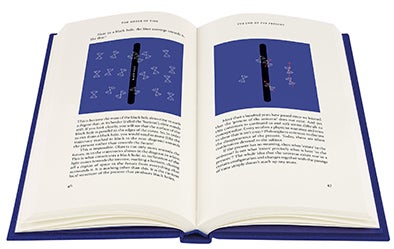
A magnificent Folio Society edition of a worldwide phenomenon. The award-winning trilogy His Dark Materials in a stunning fully illustrated hardback edition.
Introduced by Philip Pullman
Translated by Erica Segre and Simon Carnell
Designed and illustrated by Daniel Streat
The Order of Time is physicist Carlo Rovelli’s number-one bestselling exploration of the universe’s greatest mystery – time itself. Philip Pullman introduces this Folio edition featuring Daniel Streat’s unique graphic design.
‘No one writes about the cosmos like Rovelli.’
- Washington Post
Why can we alter the future but not the past, and is there any such thing as the present? We think of time as universal – moving forward, measured by clocks – but look more closely, and it reveals itself to be profoundly strange. In this thrilling dive into the nature of our universe, theoretical physicist Carlo Rovelli sweeps away all our easy assumptions. He shows that time flows faster or more slowly in different places, and vanishes altogether through the lens of quantum gravity theory. A number-one bestseller and one of Time’s ten best nonfiction books of the decade, The Order of Time is presented in a Folio edition unlike any other, thanks to award-winning designer Daniel Streat’s superb minimalist graphics. An exclusive new introduction by Philip Pullman, one of the book’s many literary fans, celebrates Rovelli’s rare gift for illuminating ‘ideas and concepts about the nature of the universe that are some of the strangest and deepest ever discovered’.
Bound in blind-blocked cloth, with gold-foil blocking
Set in Portrait with Euclid as display
216 pages in total
Printed in 3 colours
Diagrams and integrated illustrations throughout
Blocked cloth slipcase
9½˝ x 5¼˝
‘We live in an age of wonderful science writing, and Carlo Rovelli’s The Order of Time is an example of the very best. Time is something we think we know about instinctively; here he shows how profoundly strange it really is.’
- Philip Pullman, from his introduction
The Folio edition of The Order of Time stands out for Daniel Streat’s playful, inventive design in bold primary colours – starting with his eye-catching cover and slipcase, featuring a web of gold geometric lines on indigo cloth. His approach makes use of simple diagrams, formulas and graphs to illuminate mind-bending concepts, such as the curvature of space-time and the ‘light cones’ that govern our perception of it. The text is punctuated by small inset pictures, ranging from busts of Aristotle and Newton to models of the Solar System. It forms a perfect setting for Rovelli’s meditation on time, and what it is to experience it as a human through memory, longing and loss. With his formidable background as a practising physicist, he follows in the tradition of Stephen Hawking: Philip Pullman describes Rovelli in his incisive new introduction as part of ‘a great age of writing about science by those that do it’, praising his ability to use poetry as well as mathematics to guide non-physicists through the mysteries of our existence.
‘The discovery that time is not what we thought it was opens up a thousand questions,’ Carlo Rovelli writes in his preface. In the first of the book’s three sections, he peels away at conventional notions of time as something simple and fundamental, exposing them as errors of our limited perspective. He then immerses us in the strangeness of a world without time, explaining how quantum gravity can lend meaning to this ‘extreme and beautiful landscape’. Finally, he brings back the concepts of past, present and future, as ‘useful approximations used by the clumsy and bungling mortal creatures we are.’ Throughout the journey, he illustrates dizzying scientific concepts by referencing an expansive array of art, literature and music – from The Odes of Horace to the Grateful Dead, and the Indian epic Mahābhārata to Matisse’s dancers, The Order of Time is a tour de force from a true polymath: in the words of novelist and fan John Banville, ‘modern physics has found its poet.’

